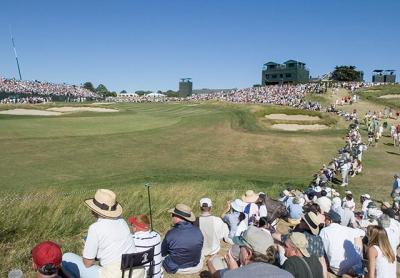Shinnecock Hills Is Ready for the Pros

A brigade of 20 or so golf carts shuttled behind U.S.G.A. officials at the Shinnecock Hills Golf Club one bright, breezy day last week to view some of the changes made since the U.S. Open was last played there in 2004.
A brisk wind was blowing out of the southwest — the prevailing wind direction here — and gusting up to 25 to 30 miles per hour. The wind can often be a defender of par at Shinnecock, as it was in 1986, when only Raymond Floyd wound up under par, by one stroke.
In 2004, the greens were the bogey, especially on the final day when, water-starved, they became exceedingly quick. The only one who wasn’t complaining was the winner, Retief Goosen, who finished at 4-under. For the rest, including Phil Mickelson, the runner-up, they were hellish. Mickelson said they were so hard that cleats would not have penetrated them.
The low-scoring amateur, Spencer Levin, likened them to the asphalt on Tuckahoe Road, and Jim Furyk and Joe Ogilvie bowed on being given a standing ovation by the five-deep gallery after they’d parred the Redan, the notorious par-3 seventh hole, one of a half-dozen stops on the U.S.G.A.’s media tour, one of which was just about where, in 1995, Corey Pavin fell to his knees after hitting a 200-yard approach shot with a 4 wood up and onto the 18th green that won him his first-ever major championship.
Could what happened in 2004 happen again, Mark Herrmann, Newsday’s golf writer, asked the chief tour guide, Jeff Hall, the U.S.G.A.’s managing director for rules and Open championships.
While the U.S.G.A. would want the greens to be firm and fast, he was “very confident,” said Hall, that what happened in ’04 would not be repeated. In fact, he added, there had been no such problem at any of the Opens played since that year.
Firmness, speed, and the health of the grass can all be regularly monitored now, by three different tools, it was said, whereas only one — the Stimpmeter — was available in 2004. They would do their best, Hall said, to leave nothing to chance.
“The major changes,” this writer’s golf expert, John Kernell, said, “are that they’ve lengthened the course since 2004 [from 6,996 to 7,445 yards], and it’s treeless, presumably the way it was when it was built in 1891.” That, said the club and U.S.G.A. officials, was their intent — to return the course to the way it was when it was first laid out.
“With the deforestation — some, as you heard them say, by nature, some by design — they’ve made it more links-style. I think the players will like it. It’s one of the iconic courses in the country. There will be no buffers anymore. I think the U.S.G.A. is hoping the deforestation will really challenge them.”
“The landing areas are still wide, though the changed angles — 10 new tees attest to that — on some holes will effectively narrow them, and, of course, the rough will be rough.”
“As with any Open,” Kernell said, “it will come down to who’s hitting the fairways and who’s putting. It looks like they’ve done a wonderful job.”
Tickets for the 118th U.S. Open, to be played at Shinnecock from Thursday, June 14, through Sunday, June 17, can be had online through usga.org.
